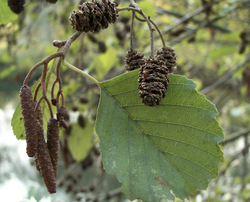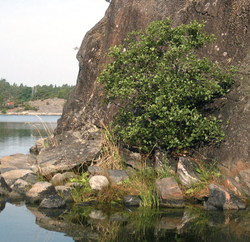 Alnus glutinosa, European Alder Alnus glutinosa, European Alder We can think of at least 180 great forest garden & perennial crops for cold climate Sweden. Want to hear about them? Over the course of the next year we will profile 5 a week on the blog. Perennial plants and crops offer a low energy, oil & resource input based foundation for future-proof agricultures. By default if an agriculture is to be called regenerative the bottom line is that it must be soil building, not soil depleting. Relentless deep tillage & poor soil husbandry (wifery?!) contributes to the majority of the 24 billion tons of topsoil lost every year on planet water. We are going to be focused on holistic polyculture grazing and perennial production at ridgedale over most of the site as this represents the most effective way to restore our degraded landscape, produce high value produce and ensure the future resource base we are managing holistically for in our decision making.  Hardy pioneer! Hardy pioneer! Genus Alnus Species glutinosa Common Name European alder Form large tree Habit clumping Origin Europe Light sun Moisture wet to mesic Other Uses fodder N fixing High (180kg p/ha +) Alnus glutinosa is common in Europe, through to Siberia, W. Asia & N Africa and thrives in moist soils, and under favourable circumstances reaches 20–30 m, though often less. It is characterized by its 5–10 cm short-stalked rounded leaves 6–12 cm long, becoming wedge-shaped at the base and with a slightly toothed margin. When young they are somewhat glutinous, whence the specific name, becoming later a glossy dark green. Found growing near water Alder can keeps its leaves longer than trees in drier situations. The species is monoecious. Flowers are wind-pollinated catkins: the slender cylindrical male catkins are pendulous, reddish in colour and 5–10 cm long; the female are smaller, 2 cm in length and dark brown to black in colour, hard, somewhat woody, and superficially similar to some conifer cones. When the small winged seeds have been scattered the ripe, woody, blackish cones remain, often lasting through the winter. The alder is readily propagated by seeds, but throws up root suckers abundantly. Alnus glutinosa is most noted for the symbiotic relationship with the bacterium Frankia alni, (Most common crop legumes have a symbiosis with Rhizobium) which forms nodules on the tree's roots. This nitrogen-fixing bacterium absorbs nitrogen from the environment and fixes it into a form available to the tree. In return, the bacterium receives carbon which is produced by the tree through photosynthesis. This relationship, which improves the fertility of the soil environment, has established A. glutinosa as an important pioneer species in ecological succession. The bark is alterative, astringent, cathartic, febrifuge and tonic. The fresh bark will cause vomiting, so use dried bark for all but emetic purposes. A decoction of the dried bark is used to bathe swellings and inflammations, especially of the mouth and throat. The powdered bark and the leaves have been used as an internal astringent and tonic, whilst the bark has also been used as an internal and external haemostatic against haemorrhage. Boiling the inner bark in vinegar produces a useful wash to treat lice and a range of skin problems such as scabies and scabs. The liquid can also be used as a toothwash. The leaves are astringent, galactogogue and vermifuge. They are used to help reduce breast engorgement in nursing mothers. A decoction of the leaves is used in folk remedies for treating cancer of the breast, duodenum, oesophagus, face, pylorus, pancreas, rectum, throat, tongue, and uterus. The leaves are harvested in the summer and used fresh. Tolerant of clipping and maritime exposure, the alder can be grown in a fast- establishing windbreak or a hedge. This is an excellent pioneer species for re-establishing woodlands on disused farmland, difficult sites etc. Its fast rate of growth means that it quickly provides sheltered conditions to allow more permanent woodland trees to become established. In addition, bacteria on the roots fix atmospheric nitrogen - whilst this enables the tree to grow well in quite poor soils it also makes some of this nitrogen available to other plants growing nearby. Alder trees also have a heavy leaf canopy and when the leaves fall in the autumn they help to build up the humus content of the soil. Alder seedlings do not compete well in shady woodland conditions and so this species gradually dies out as the other trees become established. According to the phytomass files, annual productivity is estimated at 6 to 9 tonnes per hectare. The tree has yielded 11.8 tonnes per hectare per annum on pulverized fuel ash and annual productivity has been estimated at 8.66 tonnes per hectare, with 5.87 tonnes in wood, bark, and branches, 2.79 tonnes in foliage. Alder is important as coppice-wood on marshy ground. The wood is very durable in water, elastic, soft, fairly light, easily worked, easily split. It is often used for situations where it has to remain underwater and is also used for furniture, pencils, bowls, woodcuts, clogs etc. It is much valued by cabinet makers. The wood also makes a good charcoal, and is traditionally used for smoking fish, etc. Various dyes are made from Alder. OUR FRIENDS AT PFAF HAVE AN AMAZING DATABASE OF SPECIES (UK BASED);Alnus glutinosa
Sign up to our newsletter for articles/ updates you choose & fortnightly awesome book giveaways...
0 Comments
Leave a Reply. |
Details
Like us on FB Below for regular updatesStay up to date with customized updates you want to receive
Upcoming coursesArchives
December 2016
Categories
All
|

 RSS Feed
RSS Feed